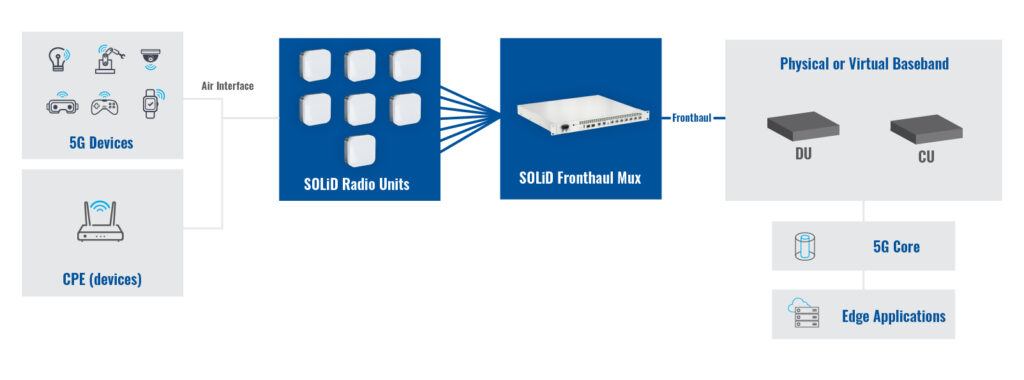Mobile networks are constantly evolving, and advancements in neutral host distributed antenna system (DAS) technology are keeping pace, enabling more efficient, scalable, and reliable connectivity. As a result, wireless in-building service quality is generally much improved over what it was in the early days of DAS, even as demand for mobile data skyrockets. And yet, to properly receive the latest wireless signal sources from multiple operators, in-building DAS systems must continue evolving to match mobile network operator (MNO) infrastructure transformations.
The growing adoption of 5G technology is driving the need for further changes in the mobile network, including greater cell site densification. However, more than 450,000 outdoor small cell nodes were already operating across the U.S. by the end of 2022, making new site build-out increasingly difficult. This challenging situation requires new approaches to network deployment and management.
Transformation Ahead
Today, in-building coverage is commonly provided by traditional neutral host DAS infrastructure shared by multiple operators. This familiar in-building coverage model has been used for many years and is universally accepted and proven. Although MNOs share the DAS equipment, they have their own radio access network (RAN) infrastructure, providing full visibility and control of the radio access network.
As MNOs face ever greater economic pressures and coverage mandates worldwide, the need to further drive down costs is inevitable even as they strive to densify coverage. Active RAN sharing helps MNOs reduce costs and avoid potential performance and maintenance problems caused by over-building their networks. This shared infrastructure approach to network deployment provides several benefits, from improved cost efficiencies to reduced environmental impacts.
When transitioning to an active shared RAN model in the future, MNOs will have various neutral host network configuration possibilities as follows, ranging from minimum to maximum sharing:
MORAN
With a multi-operator RAN (MORAN), multiple MNOs share radios, antennas, towers, and power, but each has dedicated baseband units (BBUs). A ‘shared O-RU’ feature, which the O-RAN Alliance working group four is standardizing, is a cost-effective option in O-RAN networks. This configuration allows full visibility and control of BBU equipment but requires changes to fronthaul switches to enable multiple interfaces. A shared, multi-operator RAN deployment can be used with licensed spectrum for a public network or with Citizens Broadband Radio Service (CBRS) spectrum for private networks – either over general authorized access (GAA) channels or using priority access license (PAL) channels for dedicated bandwidth.
MORAN + BBU Sharing
The amount of RAN sharing increases marginally with MORAN + BBU sharing. This co-location model involves multiple operators sharing all RAN equipment while each MNO still uses its dedicated spectrum. This configuration helps reduce BBU and fronthaul costs but still limits the visibility of the RAN network.
MOCN
Finally, with the multi-operator core network (MOCN) architecture, multiple MNOs share one or more CBRS channels to achieve maximum RAN sharing and cost efficiency. A key difference between MOCN and MORAN is the sharing of spectrum, allowing MNOs to pool spectrum allocations for greater resource efficiency. Although the lead operator in this deployment may have access to some dedicated spectrum channels and RAN control, this scenario affords limited visibility of the RAN for all other operators and GAA spectrum dependency.
DAS Evolution
As future mobile networks evolve to progressively greater architecture sharing, cost and efficiency benefits will increase, even as operator flexibility and control decrease. Likewise, these macro network changes will also impact how in-building DAS equipment operates, requiring DAS architecture to evolve as well. Future DAS architecture will share the distribution and intermediate layers between the DAS headend and the MNO networks.
When considering the difference in shared spectrum between DAS/MORAN and MOCN, MOCN will be an efficient solution for small venues or enterprise networks where coverage is more critical than capacity. We could also expect further enhancements from a neutral host DAS standpoint when converged with MORAN.
Currently, most neutral host DAS platforms use separate RANs for each MNO, but greater efficiency is possible if the RAN portion becomes MORAN. Fundamentally, RAN provides capacity, and neutral host DAS distributes capacity from multiple MNOs to multiple antenna points. In a case of extreme capacity sharing, neutral host DAS becomes more cost-efficient than MORAN because MORAN radios with a function of (Low) PHY will be more expensive than DAS radios. In fact, neutral host DAS with an O-RAN (eCPRI) interface to MORAN with BBU sharing could be the most efficient in-building solution.
A Solid Future
With the inevitable evolution of mobile networks, a RAN sharing model may eventually offer greater cost-efficiency when providing in-building coverage for small and medium-sized venues. This transformation won’t happen overnight, but when it does, SOLiD’s neutral host DAS will evolve to keep pace. In fact, SOLiD already offers Open RAN architectures to support private networks over CBRS. These next-generation architectures provide a logical stepping stone to future DAS components that work with RAN sharing.
SOLiD is leading this progression at the forefront of in-building technology advancements to ensure that DAS systems continue evolving in lock step with MNO infrastructure. Trust SOLiD to deliver the latest technologies for always-on, everywhere, in-building connectivity and interoperability testing for both public and private networks. To learn more, visit https://solid.com/open-ran/
